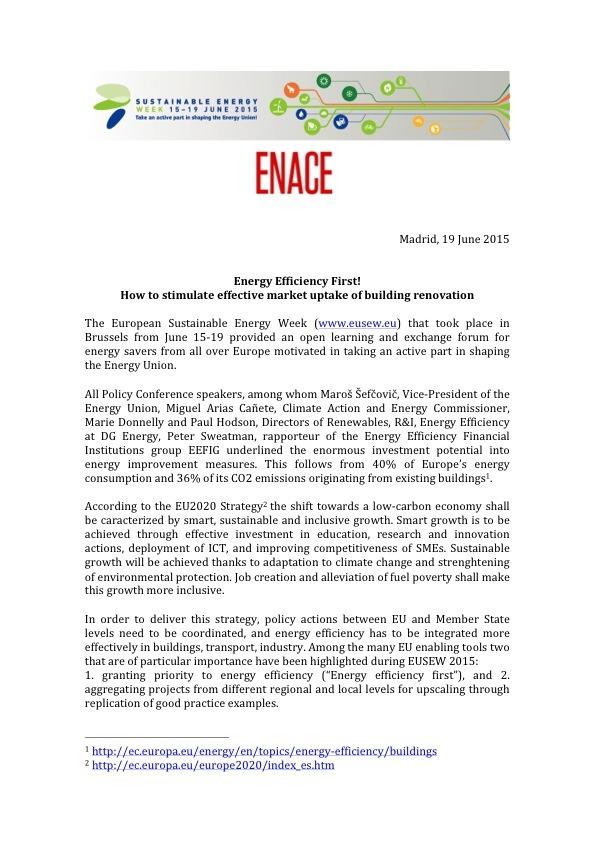Energy Efficiency First! How to stimulate effective market uptake of building renovation

The European Sustainable Energy Week (www.eusew.eu) that took place in Brussels from June 15-19 provided an open learning and exchange forum for energy savers from all over Europe motivated in taking an active part in shaping the Energy Union.
All Policy Conference speakers, among whom Maroš Šefčovič, Vice-President of the Energy Union, Miguel Arias Cañete, Climate Action and Energy Commissioner, Marie Donnelly and Paul Hodson, Directors of Renewables, R&I, Energy Efficiency at DG Energy, Peter Sweatman, rapporteur of the Energy Efficiency Financial Institutions group EEFIG underlined the enormous investment potential into energy improvement measures. This follows from 40% of Europe’s energy consumption and 36% of its CO2 emissions originating from existing buildings[1].
According to the EU2020 Strategy[2] the shift towards a low-carbon economy shall be caracterized by smart, sustainable and inclusive growth. Smart growth is to be achieved through effective investment in education, research and innovation actions, deployment of ICT, and improving competitiveness of SMEs. Sustainable growth will be achieved thanks to adaptation to climate change and strenghtening of environmental protection. Job creation and alleviation of fuel poverty shall make this growth more inclusive.
In order to deliver this strategy, policy actions between EU and Member State levels need to be coordinated, and energy efficiency has to be integrated more effectively in buildings, transport, industry. Among the many EU enabling tools two that are of particular importance have been highlighted during EUSEW 2015:
1. granting priority to energy efficiency (“Energy efficiency first”), and 2. aggregating projects from different regional and local levels for upscaling through replication of good practice examples.
Nowadays EU funding for energy efficiency clearly is targeted and limited to projects that trigger mobilization of private investment. However, ad hoc approaches not being efficient enough, standardisation and capacity building need to be fostered massively. This need was expressed not only by the Commission itself, but also by EEFIG[3], eu.esco[4], EFIEES[5] and coordinators of several EU-funded projects such as TRANSPARENSE[6], EESI2020[7] and ICP Europe[8].
With regard to the difficulties encountered while implementing the Energy Efficiency Directive 2012/27/EU, notably article 8 about energy audits, several suggestions were submitted to the Commission with view to improving the text at the occasion of its revision. For example, replacing the criteria for classifying companies according to their SME status/number of employees by the energy use criterion. Indeed the energy savings potential and improvements in efficiency are rather correlated with energy use than with the number of employees or anual turnover of a company.
Furthermore, industry representatives called for a practical implementation guide that serves as a handbook for effective compliance. The current lack of standardization bears the risk of leading large enterprises to carry out these audits as fast as possible before the deadline of 5 December 2015 in every single of its entities located on EU territory just to deliver compliance, missing however the benefits of a systematic approach. Indeed, for energy performance data to be reliable and comparable the energy audit process needs to be implemented according to common standards, and minimum requirements as to the professional qualification of energy auditors.
Where Member States fail to do so, it is up to industry players hand in hand with civil society actors to fill that gap. In this line of action the Spanish Association of Energy Auditors and Certifiers ENACE contributes to ensure within Spain and the EU internal market the availability of a sufficient number of building technicians that are adequately prepared for carrying out high-quality energy audits that are cost-effective[9].



